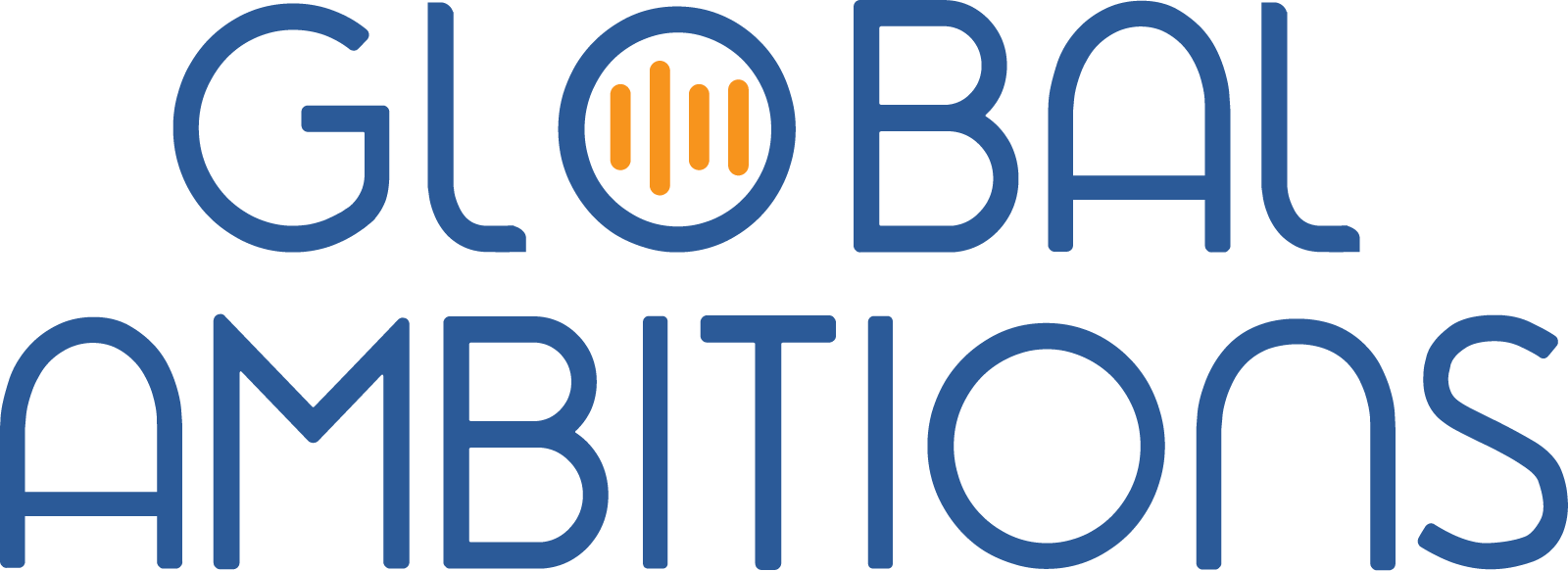With Giulia Greco, Head of Localization at Shopify
Below is a full transcript of this episode
Antoine Rey
Hi, I’m Antoine Rey, and I’ll be your host today for this Global Ambitions podcast episode. And today my guest is Giulia Greco, who’s head of localization at Shopify. And today we’re going to be talking about centralized versus decentralized. So, Giulia, welcome to the program.
Giulia Greco
Thank you.
Antoine Rey
So I’ll dive straight into this. And I believe there’s a lot of changes in the lay of the land at Shopify. Can you tell us a little bit more about your thoughts on the new centralization effort?
Giulia Greco
Absolutely. So Shopify has had a fragmented localization set up. We had 3-4 localization teams. A marketing localization team, which is the team I’ve always belonged to, the team that I helped set up from the beginning, a product localization team, a support localization team. And then we have a fourth team that’s a little more recent. That is buyer-facing, meaning that they’re a team that works on providing localization solutions for our client’s clients. So helping Shopify merchants to localize their store so that they can sell in countries other than the country where they are from. That team is a little bit out of scope from this centralization effort that we’re trying to achieve.
So we’ve had this set up with the various teams for a few years now. I want to say about three or four years, I think. And at the beginning, it makes sense because, you know, we were just starting, and people need to stay focused on tending their little garden , you know, their type of content that is very different than the other people’s type of content. So, you know, obviously, marketing needs to be treated in a completely different way than product and than support. So you have different tools, different ways of prioritizing what’s important, different ways of doing things.
Eventually, though, as Shopify progressed in the, you know, localization maturity journey and continuum, we’ve come to a place where we realized that we were too siloed from each other. And there are projects where the content is not so cleanly and clearly divided . Shopify’s content needs to be localized. It doesn’t care about the way we are organized on our org chart and we felt like we were shipping out our chart basically to our merchants simply because of the way we were set up. So you end up having some content that is marketing, but it’s showcasing some parts of our UI and that’s pertaining to the product team, or we had some product content that has legal content embedded in it and maybe it has a component that’s also driving to growth. So if it’s driving to growth, technically it should come to my team because my team is doing marketing growth, but because it sits in a product workflow, that’s not possible. And so it’s not being treated the way it’s supposed to be treated. It’s not being handled properly from that perspective.
And this started creating problems or anyway, maybe not really creating problems, but my colleagues and I on our side, we started seeing how we could be so much better and provide a much better level of localization to our final users, our audience, if we were approaching it from a more holistic perspective. And so we’ve been, you know, trying to push this idea of centralization for a few years.
Obviously, though , localization and internationalization can be viewed as a growth engine, but it’s also, you know, something that can be polarizing internally in a company. While there were a lot of people who saw the benefits of what we were proposing, it was also something that took us a while to convince the various people in leadership that we should actually be doing it.
One of the hardest things that we had to figure out was where would a centralized team sit? Because our team started in marketing growth and it was the largest team. We were 14 people and the product team was about five or six people sitting in what we call core, which is really product. So we thought for a long time that that team should join us. And eventually, when we were able to officially merge together, it was decided that we would instead be joining them in core.
So the big marketing localization team of 14 people moved over to CORE and joined with the little team. And we’re still right now going through that transition and change management that’s needed to, you know, put everybody in the right place and figure out how we’re going to work as a one team now.
Antoine Rey
So interestingly enough, a lot of technology companies like Shopify usually have a larger team in the product side of things, and there’s a lot more investment on the product side. It seems like in your case it was a little bit the other way around and maybe more investment on the marketing side, which is not entirely surprising, but a little bit different to what I’ve observed in other companies.
Giulia Greco
Yeah, there’s an explanation that is sort of historical. The reason why this happened is because localization in Shopify was initiated by the growth team back in 2016. Shopify had this, still has this, blog that’s read by millions of people. So in 2016 it already had over 2 million readers and the blog was a content marketing effort that’s set in the growth department. So the head of growth back then thought, what would happen if we hire a bunch of translators and have this blog translated ? Obviously, we’re probably going to get more readers and more leads into Shopify. So he hired what he called the translation team and I was part of that translation team and I was the Italian translator. And so he hired for the usual suspects, like the core six languages that everybody starts with, you know, French and German and Spanish, Italian and Brazilian, Portuguese. And then we added Japanese after shortly after. So things evolved from there and that’s why localization was traditionally born in marketing growth.
When the company realized that we actually needed a proper internationalization effort. Then there was an international product line that was created, and we were also organized differently as Shopify. So we had product lines and service lines, and then that’s when the split began and when different teams were formed. So we stayed in marketing and worked on becoming really good at supporting the marketing and growth needs with tech and systems and processes that are fit for that type of content.
Whereas on the product side, they had this small team that has an adjunct sort of like a second arm of developers who are specializing in internationalization that were able to actually do all the work that was needed in terms of proper internationalization of Shopify as a service and as a product. So if you look at the team that’s in product, strictly the team that does localization is small, but then they rely on all these developers and if you look at those two combined it’s a bigger team.
So having said that, though, on our side on the marketing team, we were able to have support from leadership for the past three years which was pretty incredible. I will forever be grateful for that. So they basically enabled us to grow as a team and hire and get the headcount that we were asking for to get roles such as a vendor manager and a terminologist, and a data analyst that is only for localization. So we’ve been able to sort of fill in some key roles that allow you to go much faster and be much better.
Because otherwise, you know, what ends up happening is that you have someone like me who is running localization programs, doing vendor management on the side by, you know, and not doing a good job of either one of those two things because those are important streams of localization that should be dealt by somebody entirely. And instead you’re stretched out thin trying to do it all and not doing a good job as a result. Right.
Antoine Rey
And that shows a certain level of maturity already. And that’s probably linked to the fact that it was born within the growth marketing group there, where localization is treated in this case as a revenue growth enabler as opposed to a support service. And that’s very interesting to see. I presume as well that when you’re going through such a large change management projects there, that you have to take a lot of things into consideration and there might be some politics there. There’s definitely a lot of changes there.
From a personel perspective, you have to approach certain senior management, I guess, to sell the idea of that centralization project and the levels of engagement from the different teams might be different. There’s different technology stacks, assets, vendors, you name it. So let us know maybe what was the most challenging and what you’re still going through at the moment?
Giulia Greco
Yeah, well, we’ve just started, so I can’t tell you what’s the most challenging yet. Maybe we can revisit this in a few months. But what I can tell you is that we’re definitely looking at from a personel perspective , which ties nicely to levels of engagement. I have to merge two groups.
So there are the people that I hired and have always traditionally been under me. Now, merging with another group of people and they operate in a very different way. They use different tools, they have different systems of working, different rituals, a different tempo, a different way of prioritizing and also different team culture. So somehow I have to figure out how to bring them all together and make a cohesive team again. I think it will take some time. I think it’s going to be a lot of work on just initially training each other.
So the way I’m approaching it right now is that I’m getting one point person for each of the two groups in charge of training the other group. So they’re training each other on each other’s systems with the idea that every LPM on the team will be able to handle every type of content. It doesn’t matter if it’s marketing growth, legal product or support. I want them to learn to be able to handle every type of content and know which tools are used for what and how it’s done. And then once they are all able to do that, it should emerge kind of organically and spontaneously.
What are the systems or the processes that no longer make sense or that could be better and could be optimized? I believe in having that type of change coming from the ground up and not be top down, rather than me telling them, Does this make sense?
Antoine Rey
I do think it makes sense. It’s more like they’re the ones who are working with these processes and tools on a day-to-day basis.
Giulia Greco
They will naturally tell me what they think doesn’t make sense, or we think that this could be better if we did it this way. I have created a space on my team where there is room for that type of conversation and putting their hands up and saying, Hey, I don’t think this is efficient. Why don’t we try this instead ? And I hope that the new team that we’re getting feels that and starts contributing to that on their side so that we can holistically start merging things and creating a more fluid, seamless way of working for everybody. And that, generally speaking, generates engagement because when people feel empowered to own their work processes and some of their work decisions, they tend to be more engaged, they tend to be more satisfied . So I’m hoping that that exercise will also keep the level of engagement high the way I expect to be.
In terms of tech stack, I’m going to be a little bit at arm’s length about that. We have Oleksandr Pysaryuk on my team that you know well. So Oleks is in charge of handling that portion of the work. We’re definitely looking at harmonizing and eliminate redundancies. Right now we have two TMSs. One of them is way more expensive than the other and procurement is not happy about that, obviously. So, you know, there are stakeholders in this process.
When you say politics, definitely procurement has some expectations that by becoming one central team we will reduce inefficiencies and maybe we can save a little bit of money. Now, I don’t know if we’re going to be saving money because maybe we will find savings in some spots. But I have big plans that I want to spend the money in a good way.
Antoine Rey
More budget then.
Giulia Greco
Exactly. Exactly. But no, we definitely we are looking at, you know, transitioning out of one TMS into the other one. But Oleks is evaluating together with some other tech and developers if this is the right solution for us, given that we’re all together, etc. . So there’s a lot of work happening there because obviously there’s a lot of vendor management that needs to happen if we are eliminating one TMS and onboarding a whole other bucket of content into another TMS that so far didn’t have it.
We are also undergoing, you know, we were sharing the same big LSP already. So that’s a plus, meaning that it’s not a huge change, but we were being supported by different people in the same LSP as two different teams. So now I would like to harmonize that too. And I also want to revamp the way the LSP supports us. And we are already in conversation with the LSP on how we should be relooking at the way we do things and modernize a little bit, innovate a little bit.
I feel like it’s really important to never sit back and think, okay, we’ve dealt with X, Y, Z, and now this is how it’s going to be for the next few years. Like localization is a space where innovation happens constantly and you need to be on top of that change continuously. So I feel like there’s always room for improvement. And so this is one of those moments where we were already looking at improving with our LSP, how we’re set up in the back end in terms of workflows. The teams that support us, how they operate, etc. and now we are going to be working together with product. Then obviously it’s an absolute must. So we’re doing that too. And my vendor manager is busy. She’s definitely very busy.
Antoine Rey
Yeah, I can imagine. But we’ll give you more than a few months to revisit that. But maybe to your point earlier on in the next 9 to 12 months, maybe we revisit where you’re at and we’ll look at the successes and the challenges that you faced during that period of centralizing. Because we’re coming to the end of this podcast now, but certainly a very interesting topic to revisit and look at that again in 9 to 12 months then. But thanks very much, Giulia, for coming on the show and we’ll talk to you again very soon.
Giulia Greco
Thank you. I appreciate the opportunity and I’ll keep you posted on how it’s going.





